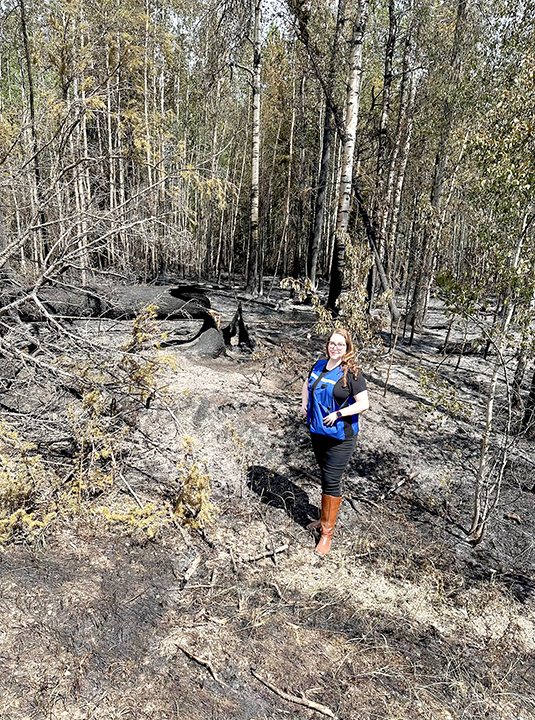Current Temperature
Island
Fire duty calls, Brennan goes to Edson
Posted on July 10, 2025 by Taber Times Times Photo Submitted by Meghan Brennan. DUTY CALLS: Meghan Brennan went to Edson as part of the All Hazards Incident Management Team (AHIMT) from the south zone.
Times Photo Submitted by Meghan Brennan. DUTY CALLS: Meghan Brennan went to Edson as part of the All Hazards Incident Management Team (AHIMT) from the south zone.By Cal Braid
Taber Times
Local Journalism Initiative Reporter
F
rom May 31 to June 5, Taber’s Communications Manager Meghan Brennan went to Edson as part of the All Hazards Incident Management Team (AHIMT) from the south zone. She served as a situation unit leader in the planning section and was deployed to the Yellowhead Fire Complex with a fellow team member from Lethbridge County and others from the north-central and central AHIMTs.
Brennan has received training as an information officer (IO) since 2016, and her first deployment was to the Kenow Fire in the M.D. of Pincher Creek in 2017.
“I really enjoyed the crisis communications aspect of being an IO and wanted to do more, so when the Province began assembling emergency management professionals throughout the south zone–circa 2018 I believe–to train them to eventually become a team, I jumped at the chance. There are five provincially funded and trained AHIMTs in Alberta,” she explained.
Her more recent deployments included 2023 in Drayton Valley/Brazeau County and 2024 in Jasper. Her experience as an IO led to her selection this year as a situation unit leader (SITL) after her team leads saw that her skills were transferrable.
While up in Edson, she worked with the other zones’ AHIMTs, as well as the Yellowhead County Fire Department, municipal staff, and Alberta Wildfire.
“While the fire was still classified as ‘out of control’ by the time we deployed, there was no longer any concern to the hamlets that were being threatened and were under evacuation order. So by the end of our deployment, those communities were able to return home,” she explained in late June.
Brennan said that her work during provincial emergencies is neither commissioned by the Town of Taber or the Province. She works on behalf of the incident command post (ICP) wherever an emergency is happening.
The ICP will request resources–in this case personnel–and then the Province will see who is available from the five regional AHIMTs.
“It filters down from the Province. But I’m not considered a Provincial employee, nor am I working on behalf of the Town strictly speaking. At that point, I’m kind of an independent contractor,” she said.
However, she isn’t deployed without first having a conversation with the Town of Taber director of emergency management and the CAO. Brennan is Taber’s information officer, and once the Town managers have been assured that the municipality is covered in case of an incident within its own borders, it approves her services to the municipality or county in need.
She explained, “These AHIMTs are able to exist because of the generosity of municipalities allowing their trained staff to respond to another municipality’s emergency in their time of greatest need. It’s a unique resource-sharing opportunity that we all hope will be there when we need it most.”
In an emergency requiring resources beyond what a municipality can muster on its own, that location pays for all the resources they request.
“So whether it’s fire trucks, pumps, hoses, evacuation centre supplies or emergency personnel like myself, that is paid through the incident. The Town of Taber taxpayer does not foot the bill for any of my deployments.”
The call to serve can come on short notice. Brennan said she keeps a close eye on developing emergencies within the province. Her training gives her a good sense of the level of complexity of each incident and whether she may receive a call to go.
“When Jasper happened, I was watching for quite a few days before I was deployed, with the sense that I should probably get ready before the call came in, and lo and behold, it did. Typically we would have around 24 hours to deploy, if we are able to go,” she said.
Upon arrival at the incident location, her days involve a morning debrief with all the command staff. Command issues directives, makes decisions, and plans accordingly throughout the day.
“When the planning section compiles the incident action plan (IAP), it’s always for the day ahead–so we are thinking about our plans for the next day,” she said about staying ahead in the game.
“When I was compiling an IAP on Monday night, it was the plans for Tuesday morning. That IAP would be signed by the incident commanders on Monday night, and then would be given at the Tuesday morning briefing to all general and command staff so they could operate throughout the day.”
And then by Tuesday, Brennan and the planning section would already be thinking about Wednesday’s plan.
“That’s how quickly emergency planning has to happen–it’s on a cycle. So when the public is evacuated or is experiencing an emergency, they can be assured the emergency personnel are already thinking about how to respond in the next day and the days to come–all while still responding to the emergency on that same day as well,” she said.
“It’s a lot of plates spinning at once, but that’s what our training helps us navigate. You have to be detail-oriented, fast–but correct–and make quick decisions based on sometimes limited information.”
She admitted the work can be stressful at times, but part of her enjoys being under pressure in those situations.
“You know what’s at stake, and you know you’re doing it to help the community you’re in,” she said. “But I also take a step back to recognize I’m in an incident command post and not actually fighting fires, or rescuing people, or knocking on doors. I’m emergency personnel, but not a first responder, so I always make that distinction in my own head whenever I get stressed. Perspective is everything.”
She said the deployments teach her a great deal and allow her to reflect on how Taber would manage its own emergency.
“Above all, my deployments and training have taught me one thing: you can never be over-prepared for an emergency. If anyone ever asks me about my deployments, that’s always the lesson I hope to leave with them.”
Leave a Reply
You must be logged in to post a comment.

